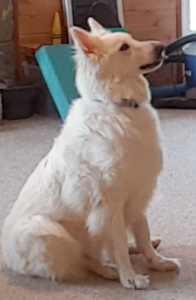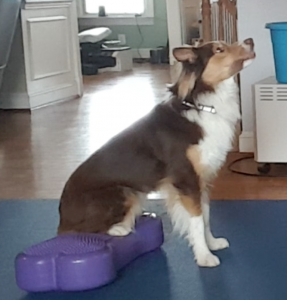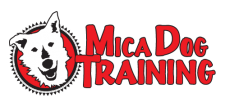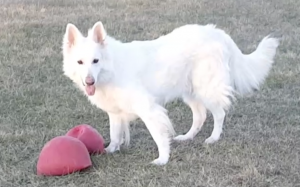Teaching our dogs to sit is a basic skill and it is one of the first things that most dogs are taught. Sit is often taught as a way of encouraging good manners. Additionally, how we teach our dogs to sit can influence their posture and overall physical well-being.
When we teach sit by stepping into our dogs, it usually works well and we get results quickly. However, we often wind up with sloppy sits. Our dogs rock back and often slump, with a big space between their front and their back feet. Their legs are spread out instead of tucked underneath them. They don’t engage their core muscles as much as we would like and their posture is not good.
Rock Back Sits Vs Tuck Sits
The first sit in this video is a rock back sit. The second sit is a tuck sit and the sit on the platform is also a tuck sit.
Can you see the difference?
A rock back sit is one type of “sloppy sit.” Some dogs also slump when they sit and kick their legs out to the side. Here’s a picture of our boy Roka in a sloppy sit.

And Why Are Tuck Sits And Posture So Important?
Pawsitive Steps Rehabilitation & Therapy for Pets, provides an excellent explanation in their blog post about sits:
“A sloppy sit from early on can slowly develop into chronic pain and overall a weak spine and abdominal (core) musculature. That being said, let’s take a look at a “sloppy” sit. With the hind limbs in this position, this dog cannot utilize them to rise from a sit and therefore will have to compensate. This compensation usually originates in the back, neck and front limbs and manifests as pain and tension. This dog will likely shift his weight forward, overloading his shoulders, elbows and carpal joints, and rely on them heavily, as well as his back to pull himself up into a stand.” (http://www.pawsitivestepsrehab.com/blog/achieving-the-perfect-sit/)
How Should We Teach Sit?
When we teach sit by luring the dog’s head up and have them move into us we can help create a nice tucked sit with knees and feet point forward and close to the dog’s body. Our dogs sit with good posture and engage more of their core muscles. For the performance/show dog this means better posture when he stacks in the ring. The agility dog has more strength for jumping and turning. And the obedience dog has a nice tucked sit position for halts and potentially straighter fronts.
Who knew how we teach sit could influence all this?
Here’s a video demonstrating how dogs often rock back when we step into them to get them to sit and how we can encourage tuck sits by inviting them to move into our space to sit.
1. Take a look at how your dog sits. What does it look like? Some dogs naturally sit like fitness models. However, most need help to identify the correct position.
2. Now ask your dog to sit and have someone watch you or take a video. Did you take a step toward your dog as you said the word sit? If you did, there are lots of other people that did too. Our bodies often want to move forward on the cue to encourage the dog to sit since our dogs usually oblige.
3. Try taking a step away from your dog and ask her to sit. Notice the difference. There is always a dog that looks exactly the same both ways but the majority of dogs will look different. Most dogs will sit a bit straighter and their legs will be more tucked in when you call them into your space instead of moving into theirs.
The article by Pawsitive Steps Rehabilitation & Therapy for Pets mentioned above contains additional suggestions for encouraging good sits, including using platforms.
Here’s our dog Clover sitting on a platform. Clover often has a rocked back sit with her rear legs pointed out. Note how tucked in she is on the platform.

Often a simple adjustment in how you ask your dog to sit can make a big difference. Since you are asking for a particular type of sit you may need to go back to using a hand signal for a bit before you add the verbal cue back in. You may even want to rename this new good posture sit since it will be quite different from your previous sit. For a long time I used a hand signal with Gambit to ensure he would sit correctly. Now if he rocks back when he sits instead of scooting forward, I simply ask him to sit again. If needed, I will help him with a hand signal.
Sometimes You Want A Rock Back Sit
There is a time and place for rock back sits where we step into our dogs. Rock back sits can be part of a physical conditioning program for your dog and can be beneficial for activating the hip flexors, core and bicep muscles. However, it is often best for the majority of your dog’s sits to be ones that encourage good posture.
Here is Gambit doing a rock back sit as part of his fitness workout:

And here is a video that reviews rock back vs tuck sits and has more examples of different types of sits.
Changing the way you ask your dog to sit can change her posture and improve her fitness.
*Some dogs due to injury and/or surgery may be unable to sit in a proper tuck sit. If you think your dog may have a physical/medical problem with sitting properly, please consult with your veterinarian.

